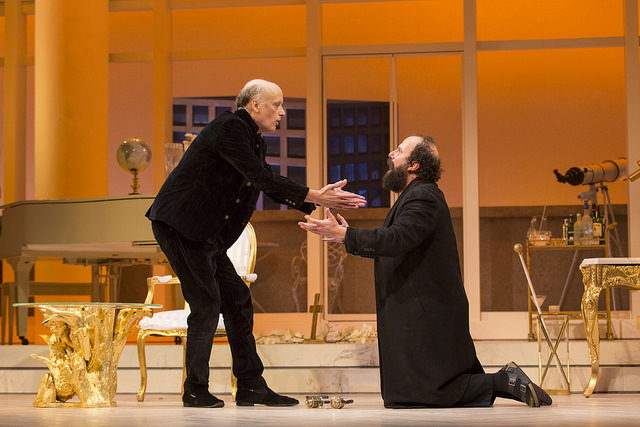 |
Jennifer Ellis in "She Loves Me"
(photo: Maggie Hall Photography) |
As has been noted here before, as joyous as it is to
fall in love, it's infinitely more wondrous to fall in love again,
with the same musical theater piece, some fifty years later, and as
the line in a reprised song says, “do call again”. In any heated
discussion of what comprises the best musical ever created,
Gypsy
and
Sweeney Todd each has its champions, but
She
Loves Me will always be regarded as a sentimental favorite of
true theater buffs. It premiered on Broadway in 1963, and has been
revived several times since. This latest version, from the Company
Formerly Known as Stoneham Theater, now Greater Boston Stage Company,
provides ample evidence for its deserved place in musical theater
history. Its Book is by Joe Masteroff, based on the Hungarian play
Parfumerie by Miklos Laszlo, with a plot which will be
familiar to film fans: 1940's
The Shop around the Corner , 1949's
Judy Garland flick
In the Good Old Summertime, and 1998's
You've Got Mail. With Music by Jerry Bock and Lyrics by
Sheldon Harnick (who would later collaborate on
Fiddler on the
Roof), it was this critic's second Broadway musical ever, and
remains his personal favorite of all time, as it is the favorite of
this production's Director and Choreograper and Associate Artistic
Director, Ilyse Robbins. Rivaling her work in last season's
Scottsboro Boys, her magic here is seamless, boasting more
excellent choreography than most productions of this musical offer,
danced and sung by a mostly impeccable cast (one actor, playing the
part of a cad, needs to lessen the scenery-chewing a bit). It's a
perfect piece in that it does what most musical theater works don't
manage, which is to provide each with her or his solo number.
Robbins must know this play well, with never a false move. And it
should be noted, given its “12 Days to Christmas” number cleverly
interspersed by Robbins with the more familiar “On the First Day of
Christmas” et al, that this is the pluperfect holiday show.
 |
Sam Simahk & Jennifer Ellis in "She Loves Me"
(photo: Maggie Hall Photography) |
The story revolves around a parfumerie in1930's
Budapest owned by Mr. Maraczek (Tom Gleadow), and his employees, the
handsome but unmarried head clerk Georg Nowack (Sam Simahk), the
ladies' man Steven Kodaly (Jared Troilo), the luminous Ilona (Aimee
Doherty), the timid Sipos (Robert Saoud), and the youthful errand boy
Arpad (Brendan Callahan). Into this melange arrives one Amalia
Balash (Jennifer Ellis), desperate for a job. She is hired by
Maraczek, but for her and Georg, it's loathe at first sight.
Unbeknownst to either of them, they are secret pen pals in a lonely
hearts club. They arrange by mail to meet in a discreet cafe led by a
hysterical (in several senses) Headwaiter (Nick Sulfaro), but the
plans go astray, as these things often do in the first act of
musicals. After some complications along the way, they finally
realize their ongoing connection. It's a very sweet tale involving
music boxes, chocolates, and above all vanilla ice cream, which
literally breaks the ice between our predestined lovers. If this is
any indication of what other possibilities lie in our future,
theatergoers should expect true wonders from Greater Boston Stage
Company. This production, with Matthew Stern on the keyboard and as
Music Director, shows off the creative talents of Scenic Designer
Brynna Bloomfield, Costume Designer Gail Astrid Buckley, Lighting
Designer Jeff Adelberg and Sound Designer John Stone. One negative
aspect was the muffled overture due to the placement of the orchestra
behind the set. It was also surprising, given Simahk's great voice,
that one song was spoken rather than sung (perhaps due to the
macarbre lyric “her left foot floating in an open brook”).
 |
Tom Gleadow, Sam Simahk, Brendan Callahan, Aimee Doherty, Jennifer Ellis & Robert Saoud
in "She Loves Me"
(photo: Maggie Hall Photography) |
Who could resist such a charming and heartwarming story,
lushly romantic while not too heavy on the
schlag? Ellis,
following in the footsteps of the original Amalia (a
then-little-known Barbara Cook) makes the role her own, and Simahk is
her perfect match (he's been away too long from Boston stages, having
been in the National Tour of
The King and I). Add to this the
wacky turns by Doherty (perhaps her best role yet), Gleadow and
Saoud, and even Callahan in an often-underwhelming role, and you have
a really embarrassing cornucopia of riches. How delicious to hear
the letter-writing Amalia speak of how the views of Georg and her “so
correspond”, Ilona of her book-loving suitor's “novel approach”,
learning Arpad's last name is Laszlo (a tribute to the original
playwright), and the heroine's paean to the ice cream the hero
brought her.
This relatively unknown musical is no secret anymore.
Until December 23rd , we can all scream we love She
Loves Me. So bring on the vanilla ice cream, and “do call
again, won't you”?

















